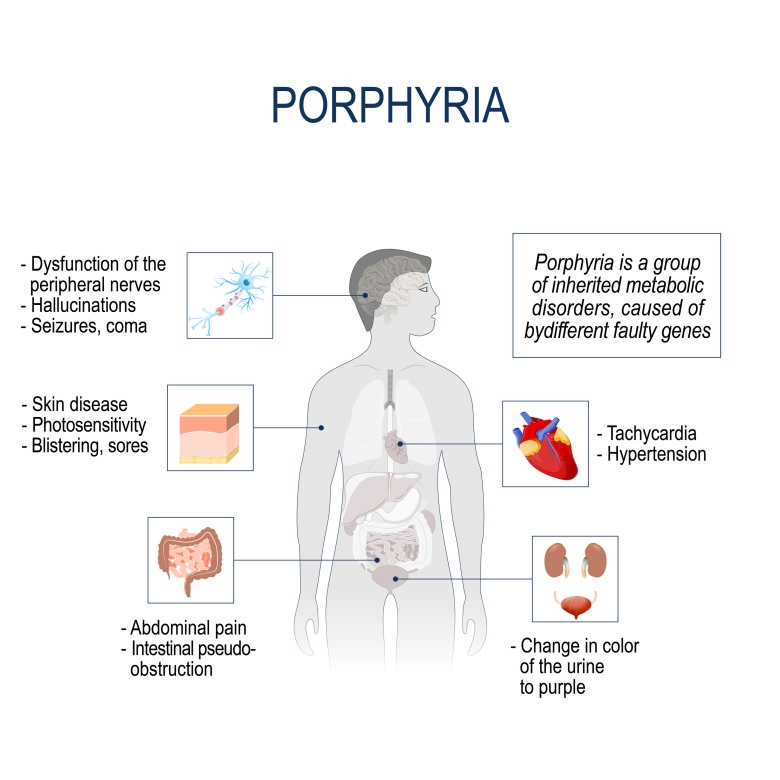Porphyria refers to a group of inherited or acquired diseases that prevent your body from properly making heme, the red pigment that contains iron. Heme is made in the bone marrow and liver. A large amount of heme is present as hemoglobin in red blood cells and bone marrow. Hemoglobin carries oxygen throughout the body. Eight enzymes are needed to create heme, and if any are lacking, the result can be a type of porphyria. Porphyria is not a single disease but a group of disorders that differ considerably from each other.
| Type of Porphyria | Deficient Enzyme |
| Acute Porphyrias | |
| ALAD porphyria | delta-aminolevulinic acid dehydratase |
| acute intermittent porphyria | porphobilinogen deaminase |
| hereditary coproporphyria | coproporphyrinogen oxidase |
| variegate porphyria | protoporphyrinogen oxidase |
| Cutaneous Porphyrias | |
| congenital erythropoietic porphyria | uroporphyrinogen III cosynthase |
| porphyria cutanea tarda | uroporphyrinogen decarboxylase (~50% deficiency) |
| hepatoerythropoietic porphyria | uroporphyrinogen decarboxylase (~90% deficiency) |
| hereditary coproporphyria | coproporphyrinogen oxidase |
| variegate porphyria | protoporphyrinogen oxidase |
| erythropoietic protoporphyria | ferrochelatase |
Porphyria is rare and is usually inherited. Acquired porphyria may result from iron or lead toxicity, alcohol use, hepatitis C, HIV, and some medicines.
Porphyrins and related chemicals are made in your body as part of the process of making heme. Certain types of porphyria cause these chemicals to pass into your urine.
A common feature in all porphyrias is the accumulation in the body of porphyrins or porphyrin precursors. Although these are normal body chemicals, they normally do not accumulate. Precisely which of these chemicals builds up depends on the type of porphyria. Porphyrins are naturally occurring chemicals found to help the production of hemoglobin. Hemoglobin is the protein in red blood cells that are responsible for carrying oxygen in the blood throughout the entire body. More than just helping to create hemoglobin, porphyrins have another influence on blood. Heme is a type of porphyrin that produces the red coloring of red blood cells. All aspects of blood, from the color to the oxygen it carries, are crucial to proper bodily function. Heme is essential for the transport of oxygen to cells in the body. If any step in the synthesis of heme is blocked, an intermediate chemical accumulates in the cell, resulting in oxygen depletion. Each type of porphyria represents a deficiency of a specific enzyme needed for the synthesis of heme.
Testing for Cutaneous Porphyrias:
| Porphyria | Urine porphyrins |
| CEP | Increased; mostly uro- and coproporphyrin I |
| PCT & HEP | Increased; mostly uro- and Heptacarboxyporphyrin |
| EPP | normal |
| XLP | normal |

Doctors may use porphyrin urine testing as part of their diagnosis of the following types of neurologic porphyrias:
- acute intermittent porphyria
- variegate porphyria
- hereditary coproporphyria
- ALA dehydratase deficiency porphyria
Origin of the word porphyria?
The terms porphyrin and porphyria are derived from the Greek word porphyrus, meaning purple. Urine from some porphyria patients may be reddish in color due to the presence of excess porphyrins and related substances in the urine, and the urine may darken after exposure to light.
What are the symptoms?
Porphyria symptoms arise mostly from effects on either the nervous system or the skin. Effects on the nervous system occur in the acute porphyrias. Proper diagnosis is often delayed because the symptoms are nonspecific. Skin manifestations can include burning, blistering and scarring of sun-exposed areas.
Treatments:
Treatment is specific to the type of porphyria. The porphyrias are inherited conditions, but don’t all follow the same mode of inheritance.
Prevalence of porphyria:
The porphyrias are rare diseases. Taken together, all forms of porphyria afflict fewer than 200,000 people in the United States. Based on European studies, the prevalence of the most common porphyria, porphyria cutanea tarda, is 1 in 10,000, the most common acute porphyria, acute intermittent porphyria, is about 1 in 20,000, and the most common erythropoietic porphyria, erythropoietic protoporphyria (EPP), is estimated at 1 in 50,000 to 75,000. Congenital erythropoietic porphyria is extremely rare with prevalence estimates of 1 in 1,000,000 or less. Only 6 cases of ALAD-deficiency porphyria are documented.
References:
- Unique Diagnostic and Therapeutic Roles of Porphyrins and Phthalocyanines in Photodynamic Therapy, Imaging and Theranostics, https://www.ncbi.nlm.nih.gov/pmc/articles/PMC3475217/
-
STRUCTURE OF PORPHYRIN TPPS4 AND ITS INTERACTION WITH METAL IONS AS ELUCIDATED BY 1H NMR AND UV-VISIBLE SPECTRA, https://www.ncbi.nlm.nih.gov/pmc/articles/PMC3615901/
-
Trafficking of Heme and Porphyrins in Metazoa, https://www.ncbi.nlm.nih.gov/pmc/articles/PMC2769250/
Disclaimer:
The information on healthmatters.io is NOT intended to replace a one-on-one relationship with a qualified health care professional and is not intended as medical advice.


This can be addressed and can lead to many other problems if not addressed like having problems with pyroles and eating proteins. I thought I it was blood coming out of me because of the red color of my urine. I also had it coming out of my eyes and nose. When I showed doctors they would not even acknowledge what they were seeing. Said it was from stress. It seems to be their answer for everything now days. If you get this reaction from doctors find a doctor who will listen. By not getting treated and addressing it in time it has caused some permanent damage to my body.
Thanks for sharing, Lee!